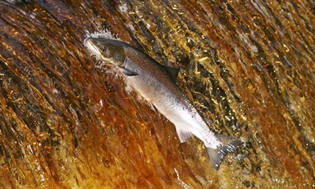 As widely predicted the Durban UN Conference on Climate Change (COP17) has failed to reach a legally-binding global agreement on pollution, with talks on a new legal deal not due to end until 2015 and with a further delay until 2020 before the implementation of any agreed emission limits. The Association of Salmon Fishery Boards (ASFB) and Rivers and Fisheries Trusts of Scotland (RAFTS) believe that this highlights the need for a greater focus on the needs of species sensitive to climate change, such as Atlantic salmon and sea trout, and their requirement to adapt to changing environmental conditions.
As widely predicted the Durban UN Conference on Climate Change (COP17) has failed to reach a legally-binding global agreement on pollution, with talks on a new legal deal not due to end until 2015 and with a further delay until 2020 before the implementation of any agreed emission limits. The Association of Salmon Fishery Boards (ASFB) and Rivers and Fisheries Trusts of Scotland (RAFTS) believe that this highlights the need for a greater focus on the needs of species sensitive to climate change, such as Atlantic salmon and sea trout, and their requirement to adapt to changing environmental conditions.
Dr Alan Wells, ASFB Policy and Planning Director said “Clearly, the first priority in mitigating the effects of climate change is to control atmospheric concentrations of greenhouse gases. While we must continue our attempts to mitigate the impacts of climate change, we must now put more focus on the development and implementation of robust strategies to help us adapt to those impacts which are now inevitable, and indeed are now becoming apparent. There is widespread agreement that a key strategy for managing adaptation of species sensitive to climate change, such as Atlantic salmon and sea trout, is to minimise additional man-made pressures.”
Alan Wells continued, “In the specific case of Atlantic salmon and sea trout, this involves concentrating on those factors which fishery managers and the Scottish Government jointly can address. These include the improvement of degraded freshwater habitat, removal of barriers to migration, reduction in exploitation where necessary[1], ensuring marine and terrestrial renewables are deployed in an environmentally sensitive and well-informed manner and addressing the negative effects of salmon farming.”
Callum Sinclair, RAFTS Director said, “In addition to the more obvious suite of environmental pressures, climate change is likely to encourage and hasten the spread of invasive non-native species across Scotland to take advantage of more favourable climatic conditions and lead to the extension or shift of species ranges. This increases the risk of impact to our important native species and habitats from these invaders”.
Callum Sinclair added, “The individual river and fishery trusts and district salmon fishery boards are taking a range of practical fishery and catchment management actions to improve the lot of the Atlantic salmon, our rivers their habitats and native species and to control both the invasive species already present and halt the spread of new invaders. From the development and implementation of Fishery Management and Biosecurity Plans to the development of large control programmes such as the Scottish Mink Initiative the wild fish sector is recognising and playing its important role in species, habitat and catchment management in Scotland.”
[1] District Salmon Fishery Boards have voluntarily adopted ‘catch and release’ practices, which in some cases are made mandatory by the introduction of Salmon Conservation Regulations. In 2010, the overall catch and release rate for salmon was 70%, rising to 86% for spring salmon.
